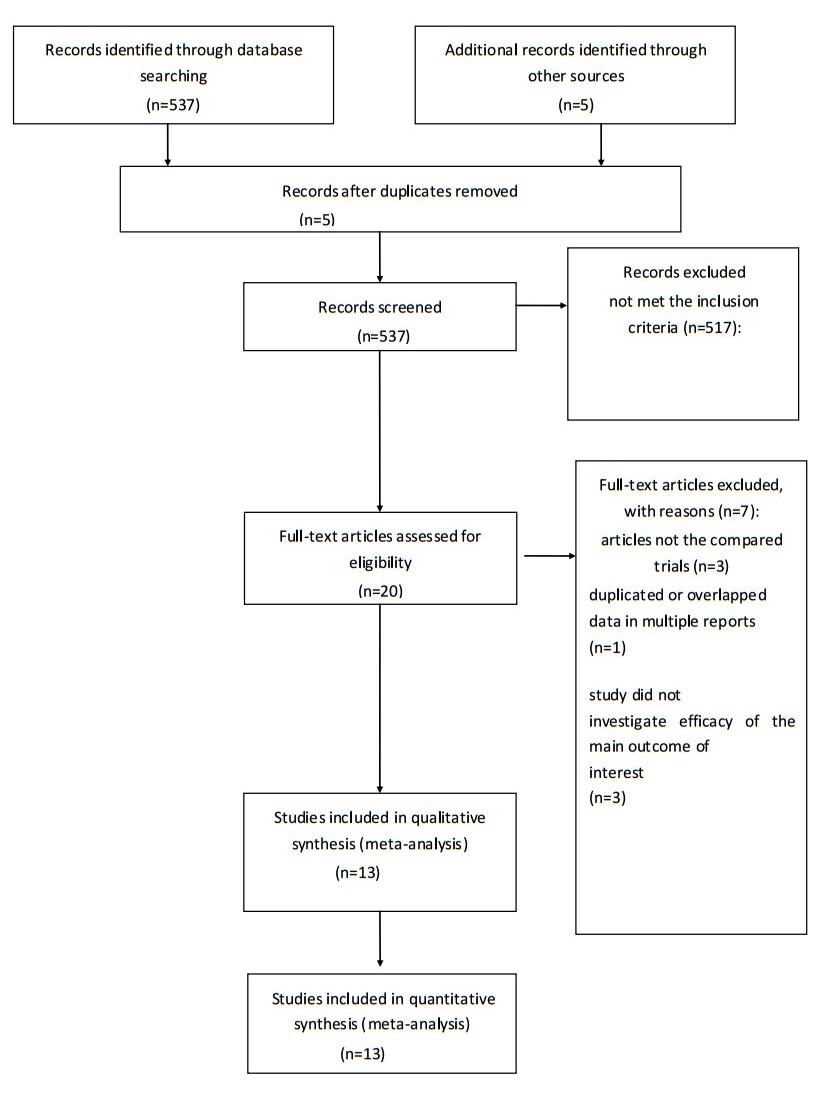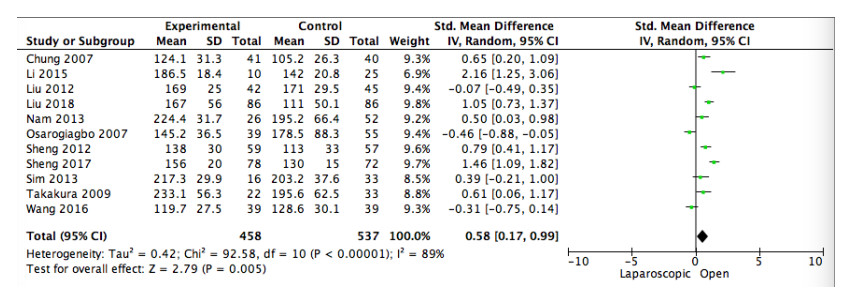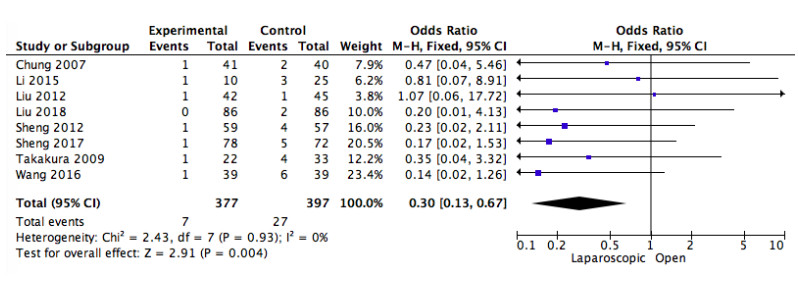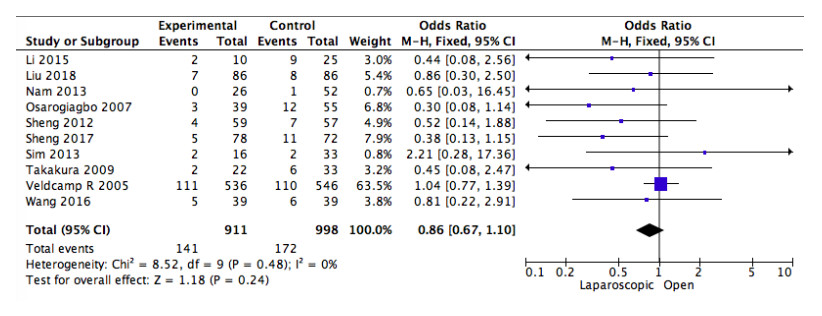1.
Introduction
Colon cancer has become the third most common cancer worldwide [1], which is a leading cause of cancer death [2]. Up to now, radical open surgery (OS) remains the major approach for the cure of colon cancer [3]. As surgical techniques and equipment have developed, several minimally invasive techniques have been increasingly used to colorectal surgery in the past decades.
Laparoscopy-assisted colectomy (LAC), as a minimally invasive approach, has gained acceptance in colon cancer due to its proven benefits [4,5]. It has been reported to be a superior approach for colon cancer benefit from improving postoperative short-term effects, with quicker recovery and fewer perioperative complications [6,7]. While, LAC still has some limitations, such as complexity, technically demanding, the prolonged operative time, long learning curve, lack of tactile feedback, the cost effectiveness of laparoscopic techniques, and the potential for port site recurrence of tumor [8,9,10].
Some studies have compared the outcomes of LAC and OS for colon cancer. However, its superiority and safety are still controversial [11,12]. The primary aim of the current study was to compare the clinical outcomes between LAC and OS for colon cancer, and determine whether laparoscopic resection is non-inferior to open resection for colon cancer.
2.
Materials and method
2.1. Subheading search strategy
Two investigators independently conducted a systematic literature search for journals published using Pubmed, Embase, and Cochrane library until May 2018. The main search terms were: "colon carcinoma" "laparoscopic surgery" and "open surgery", and relevant Medical Subject Heading (MeSH) terms were utilized. Two investigators also hand-searched relevant reference lists of all articles that dealt with the topic of interest for additional relevant publications.
2.2. Eligibility criteria
Studies were included in the meta-analysis should meet the following criteria :(1) the studies that compared open and laparoscopic surgery; (2) studies involving colon cancer patients; (3) studies providing data of surgery-related outcomes and postoperative specimens for both two groups, and HRs with corresponding 95% CIs were provided; (4) the original literature should provide complete data were only included. The studies that did not meet the above inclusion criteria would be excluded from the meta-analysis.
2.3. Quality assessment
Two investigators separately rated the quality of the retrieved studies. Study quality was assessed using Newcastle-Ottawa Quality Assessment Scale.
2.4. Data extraction
The data extraction was conducted independently by two authors (Jin-Li Sun, Su-Zhen Xing). Disagreement was revolved by consensus. From each of the eligible studies, the main categories based on the following: the first author, published the year, country, study design, tumor location, sample size, age, the outcomes of interest including surgery-related outcomes and postoperative specimens.
2.5. Statistical analysis
We performed the meta-analysis by pooling the results of reported incidence of intraoperative parameters and postoperative parameters. Results will be expressed as mean differences for continuous outcomes (standardized vs. weighted to be determined by available data); and the appropriate ratio/difference for dichotomous outcomes as determined by available data.
The main outcomes of studies were, surgery-related outcomes and postoperative specimens. If HRs and corresponding 95% CIs were reported, lnHRs and the corresponding lnLLs and lnULs were used were directly extracted from studies.
A sensitivity analysis was also performed to examine the impact on the overall results, depending on the heterogeneity across the included studies. The heterogeneity across studies was examined the I2 statistic [13]. Studies with an I2 of 25-50%, 50-75%, or > 75 % were considered to have low, moderate, or high heterogeneity, respectively [14]. When there was low and moderate heterogeneity among studies, the fixed-effects model was used. Otherwise, the random effects model was used. A P value less than 0.05 was considered statistically significant. The statistical analyses were performed using Review Manager version 5.3 software (Revman; The Cochrane collaboration Oxford, United Kingdom). Findings of our meta-analysis were shown in forest plots. The Begg test and the Egger test were conducted to evaluate publication bias.
3.
Results
3.1. Overview of literature search and study characteristics
A total of 537 studies were retrieved initially for evaluation. Based on the criteria described in the methods, 20 publications were evaluated in more detail, but some did not provide enough detail of outcomes of two approaches. Therefore, a final total of 13 [9,15,16,17,18,19,20,21,22,23,24,25,26] studies were included in this meta-analysis. The search process is described in Figure 1.
All included studies in this study were based on moderate to high quality evidence. Table 1 describes the primary characteristics of the eligible studies in more detail.
3.2. Clinical and methodological heterogeneity
Pooled analysis of operate time comparing open with laparoscopic surgery.
Pooling the data from 11 studies showed that laparoscopic surgery has a trend longer operative time (SMD = 0.58, 95% CI 0.17-0.99; P=0.005) compared with the open group (Figure 2).
Pooled analysis of length of hospital stay and postoperative hospital stay comparing open with laparoscopic surgery
A random-effects model was used to pool hospital stay (SMD = -0.57, 95% CI -1.00--0.15; P = 0.008) and postoperative hospital stay (SMD = -0.66, 95% CI -0.99--0.33; P = 0.0001), since there was high heterogeneity across the studies. The pooled data showed that hospital stay rate was shorter in laparoscopic surgery compared with open surgery (Figure 3-4).
Pooled analysis of blood loss comparing open with laparoscopic surgery
The rate of blood loss was available for 8 trials. Results showed that there was less blood loss (SMD = -0.68, 95% CI -1.12--0.24; P = 0.002) with laparoscopic surgery (Figure 5).
Pooled analysis of incision length comparing open with laparoscopic surgery
Incision length data was available for 6 studies (Figure 6). The agammaegated results suggested that there was shorter incision length (SMD = -4.61, 95% CI -5.79--3.43; P < 0.00001)in laparoscopic surgery group.
Pooled analysis of infection comparing open with laparoscopic surgery
Overall, 8 studies and 6 studies reported data on wound infection and pulmonary infection were shown in (Figure 7-8), respectively. Pooled data showed that laparoscopic surgery had less wound infection (OR = 0.30, 95% CI 0.13-0.67; P = 0.004) than surgery group, while no statistically significant level was found in pulmonary infection (OR = 0.52, 95% CI 0.18-1.49; P = 0.22).
Pooled analysis of operative parameters comparing open with laparoscopic surgery
In the analysis of dissected lymph nodes (P = 0.17), ileus (P = 0.91) and postoperative parameters (P = 0.24) with comparing open with laparoscopic surgery for colon cancer, and the data are shown in (Figures 9-11). While, all above data does not reach a statistically significant level.
4.
Discussion
Total mesocolic excision (TME) is considered to be the standard practice for colorectal cancer patients due to it can decrease disease recurrence and prolong long-term survival [27]. With the development of surgical techniques and equipment, the minimally invasive surgery for colorectal diseases has been extended [28,29,30,31].
Laparoscopic colectomy, as a minimally invasive approach, for colon cancer has been introduced to surgical fields since 1991 with its own merits [16]. Plenty of prior studies demonstrated the feasibility, safety, short-term advantages and reductions in stress and immunosuppression of laparoscopic surgery compared with open approach [32,33,34,35].
Despite this, with regard to emergency patients with obstructive right colon carcinoma, laparoscopic surgical management is not recommended as a superior approach. Because the proximal expansion of the intestine has taken place of the abdominal space in these patients and the risk of injuring the distended bowel during manipulation was high [36]. So, the open surgery is often the first choice for these subjects. In addition, it is difficult for some obstructive colorectal cancer patients to accept the laparoscopic minimally invasive therapy, as it can be technically demanding and difficult to learn and teach [37,38,39,40].
This article aims to compare the feasibility, safety and short-term outcomes between LAC and OS groups for colon cancer patients. At the same time through this study, let us have an ideal choice between laparoscopy and open surgery in colon cancer patients.
In terms of intra-operative outcomes, the length of incision was significantly shorter and the blood loss was less in LAC group than OS group, which suggested that LAC is more precise. The amount of bleeding will directly affect the surgical field of vision, and even the surgeon was forced into the abdominal surgery, which laparoscopic surgery failed. Patients in the LAC group lost less blood than in the OS group, which is probably because those patients experienced less invasive procedures during the laparoscopic surgery, which with clearly blood vessels exposure [41]. Laparoscopic surgery for CRC was superior to open surgery with high-definition, enlarged exposure characteristics.
While, the numbers of lymph nodes retrieved had no significance difference between two groups, which showed the similar results consistent with previous study [32,40]. In the case of malignant disease, both the feasibility of surgery and its oncologic safety should be considered and evaluated. The number of retrieved lymph nodes could be one parameter describing the extent of lymph node dissection. In order to achieve maximum lymph node dissection, not only the need for tumor and surrounding tissue resection but also the need for central vascular ligation (CVL) was required [41]. We explained it that the root ligation of central blood vessels may increase the risk of intraoperative bleeding in terms of laparoscopic high-definition vision and the amplification of vascular tissue effect. While, there is the more long-term follow-up and investigation of tumor outcome need to be explained this result.
As far as the operative time is concerned, our study showed that the operation time was longer in the LAC group than in the open surgery group as well as in most previous studies [42,43,44]. Surgery time is not only related to the various types of operations but also the surgeon's experience. With the improvement of operation skill and cooperation, the operative time will decrease. How to reduce the operation time under the premise of affecting the radical tumor, has been the most sought for surgeons.
Prolonged ileus is a common complication of colon surgery. By examining the postoperative results, no significant difference was observed in ileus, it might be because the occurrence of ileus is a complex procedure and many factors can contribute to it, such as chronic pulmonary disease, inhibitory gastrointestinal tract reflexes, local inflammatory responses, prolonged total surgical time and pharmacologic interactions [45,46,47,48]. Despite the fact that previous studies reported a lower rate of ileus in patients received preoperative oral antibiotic bowel preparation [49], the benefits and adverse reaction of oral antibiotic bowel preparation should be further validated. Promoting bowel function recovery after laparoscopic surgery has been a hot topic in CRC surgery [50,51,52]. Moreover, similar difference in the total incidence of short-term postoperative complications rate between these two groups in our study. However, the incidence of wound infection was significantly less with LAC than OS group due to the shorter incision. So, LAC is as safe and feasible as OS.
Besides, hospitalization time was an important indicator of patient rehabilitation. As the minimally invasive features of laparoscopic CRC could be translated into better postoperative recovery out-comes, and most patients had shorter hospital stay than open surgery [53,54,55,56]. Our study showed that a faster recovery of the LAC group compared with the OS group.
In general, along with the technical development, clinicians have encountered some new problems in daily work. Laparoscopic colorectal surgery required not only the experience of CRC surgery but also the need for high laparoscopic stills and techniques. The key to successfully performing laparoscopic minimally invasive treatment for obstructive colon cancer patients is to provide enough space for the laparoscopic operation. What's more, the careful patient selection with preoperative computed tomography scanning is also needed to avoid invalid operations and complications.
The main strength of our study is the use of a well-maintained and updated database. Nevertheless, due to all included studies' retrospective nature, bias still exist, and this may impact the comparison of survival outcomes. While, considering that the preferred surgical procedure varies dramatically among surgeons and serious ethical need to concerned, it is very difficult to set up a randomized controlled clinical trial (RCT) to compare the survival prognosis of patients undergoing laparoscopic surgery and open surgery for the treatment operating on colon cancer patients.
5.
Conclusion
In conclusion, we present a meta-analysis that compared the short-term out-comes of LAC and OS for the treatment of colon cancer patients. The LAC procedure is associated with smaller incision, less operative blood loss, less postoperative wound infection, and shorter duration of hospital stay than OC group. Although there is an increased operative time in the LAC group, we believe that this technique is safe and feasible method for colon cancer patients. However, to address the role of LAC in the curative management of colon malignancies, long- term follow-up and large prospective multi-center population-based studies is not only required, but also pressing.
Conflict of interest
The authors declare that there are no actual or potential conflicts of interest in relation to this article.










 DownLoad:
DownLoad:












